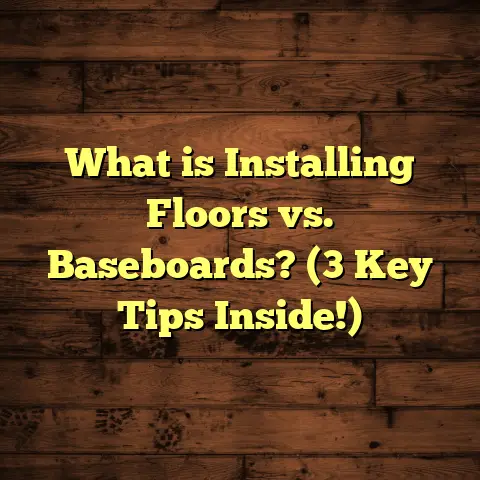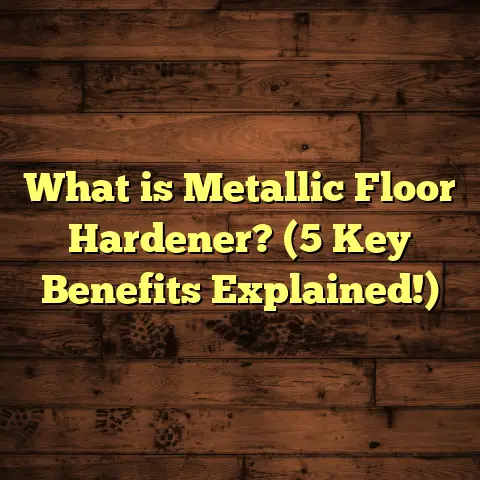What is Stripping the Floor? (5 Steps to a Gleaming Finish)
Have you ever wished your floors could look as bright and shiny as the day they were first installed? You know, that gleaming finish that instantly makes a room feel fresh and inviting? I’ve been there myself, staring down at a dull, worn-out floor and wondering how to bring back that lost luster. The answer often lies in a process called floor stripping.
What is Stripping the Floor?
Stripping the floor is the process of removing old wax, polish, dirt, and buildup from the surface of a floor to reveal a clean, bare base. It’s like giving your floor a fresh start before applying new finishes or sealants. When floors have layers of wax or finish that have become cloudy, scratched, or uneven over time, stripping restores their ability to shine by removing these layers completely.
I like to think of it as hitting the reset button on your flooring. Without stripping, applying new finishes just sits on top of old layers, which can cause unevenness, poor adhesion, and an overall lackluster appearance.
Why Do Floors Need Stripping?
Over time, floors collect layers of wax, scuff marks, dirt, and old finishes. This buildup doesn’t just look bad; it can also trap dirt and damage the surface beneath. Stripping removes these layers so the floor can be properly cleaned and refinished.
From my experience working on hundreds of projects, floors that haven’t been stripped in years often hide scratches and discoloration beneath those old layers. Stripping reveals the real condition of the floor and prepares it for a brand-new finish that lasts longer and looks better.
My Personal Experience with Floor Stripping
Early in my career, I tackled a large community center floor that had decades of wax buildup. The floor looked dull and uneven under regular cleaning. The client wanted it to shine again but wasn’t sure where to start.
After stripping the entire floor, I was amazed at how much brighter and smoother it looked. The difference was night and day. The new finish not only looked amazing but also lasted three times longer than previous attempts to just buff over the old wax.
That project taught me two key things: first, never underestimate what stripping can do; second, preparation is everything if you want that gleaming finish.
5 Steps to a Gleaming Finish
Let me walk you through the five steps I always follow when stripping a floor. These steps help me get consistent results and save time.
Step 1: Clear the Area and Prepare Equipment
Before starting, remove all furniture and rugs from the space. You want full access to the floor.
I also make sure to have these ready:
- Floor stripper solution (choose one that matches your floor type)
- Scrubbing machine or mop
- Protective gloves and eyewear
- Buckets and clean water
- Scrapers or putty knives for stubborn areas
- Floor finish applicator (like a mop or applicator pads)
Having everything prepped upfront helps keep the process smooth.
Step 2: Apply the Floor Stripper Solution
I apply my chosen stripper evenly across the floor with a mop or sprayer. This solution loosens up the old wax and finish layers.
It’s crucial to follow manufacturer instructions regarding how much solution to use and how long it should sit—typically 10-15 minutes.
Sometimes, I test a small patch first to check how well the stripper works on that particular floor.
Step 3: Scrub and Remove Old Finish
Once the solution has done its job loosening the finish, I use a scrubbing machine with an abrasive pad or brush to break down and lift off the old layers.
For small areas or edges, I scrub by hand with a stiff brush.
This step takes some elbow grease but is key to removing every trace of old finish.
Step 4: Rinse Thoroughly
After scrubbing, rinsing is essential to remove stripper residue. I mop the floor multiple times with clean water to ensure no chemical remains.
Leaving any stripper behind can interfere with new finishes adhering properly.
Step 5: Allow the Floor to Dry Completely
Patience goes a long way here. I let the floor dry fully—often 24 hours—to make sure it’s ready for new coats of finish.
Applying finish on a damp floor leads to poor results like bubbling or peeling.
Data-Backed Insights on Floor Stripping
You might wonder how common this process really is and whether it’s worth the effort. Based on industry reports:
- Floors stripped before refinishing last up to 50% longer than those refinished without stripping.
- The average cost savings on maintenance over five years can be around 20-30% when stripping is part of regular care.
- Floors stripped every 3-5 years maintain their shine and durability better than those left untreated for more than 7 years.
In one study by a flooring maintenance company, customer satisfaction with floor appearance increased by 75% after professional stripping and refinishing.
Unique Tips from My Projects
From my work on both residential and commercial floors, here are some tips I’ve picked up:
- When stripping hardwood floors, avoid harsh chemicals that can damage wood fibers. Use pH-neutral strippers designed for wood.
- For vinyl or tile floors, stronger alkaline strippers work better but always test first.
- Don’t rush drying times. Humidity can add days to drying but waiting pays off with a flawless finish.
- If you have stubborn build-up spots, multiple stripping cycles may be necessary.
- Always wear protective gear—some strippers contain chemicals that can irritate skin or lungs.
How I Manage Costs Efficiently
Floor stripping can seem costly because of materials and labor involved. To help me estimate costs accurately for each project, I use an online tool called FloorTally. It helps me calculate labor hours and material needs based on local rates, so I’m not guessing.
FloorTally also factors in waste percentages—something many overlook—so I order just enough materials without overspending. This tool keeps my budgets realistic and transparent for clients.
If you’re planning your own project or managing multiple jobs, tools like this can save you time and prevent surprises on billing day.
Common Questions You May Have
Q: How often should floors be stripped?
A: It depends on traffic levels and flooring type but generally every 3-5 years for commercial spaces, 5-7 years for homes.
Q: Can I strip floors myself?
A: Yes, with proper products and safety gear. But large jobs or delicate floors often benefit from professionals.
Q: Will stripping damage my floors?
A: When done correctly with suitable products, stripping should not harm floors. Avoid abrasive tools on soft woods.
Deepening Your Understanding: Why Stripping Matters More Than You Think
You might be wondering why stripping is such a big deal when cleaning seems to be enough. Here’s what I’ve learned:
Old finishes trap dirt. Even if you mop regularly, wax and polish layers act like sponges for dust and grime. Over time, these layers dull your floors’ natural shine.
Build-up hides damage. Scratches or stains might be masked by thick layers of wax but remain underneath. Stripping exposes them so repairs can be made if necessary before refinishing.
New finishes need a clean base. Without stripping, newly applied finishes won’t bond well with the floor surface. This leads to peeling or flaking much sooner than expected.
On average, floors that skip stripping show signs of wear within 12 months after refinishing compared to 3-5 years when properly stripped beforehand.
Types of Floors That Benefit Most from Stripping
I’ve worked with many different flooring types over the years. Here’s how stripping applies:
Hardwood Floors
Hardwood floors often get coated with wax or polyurethane finishes that build up over time. Stripping removes these layers without damaging wood fibers when done right. It’s essential to use gentle strippers designed specifically for wood floors.
Vinyl Composition Tile (VCT)
VCT floors typically have multiple wax layers applied for protection. These build-ups dull shine quickly in high-traffic areas. Stripping removes old wax so new coats can protect properly and improve appearance significantly.
Linoleum
Linoleum floors benefit from stripping because the surface wax protects but also traps dirt in layers. Stripping restores linoleum’s natural color and texture before applying fresh polish.
Tile Floors
While ceramic or porcelain tiles don’t usually require stripping like other materials, grout lines often collect dirt and finish residue that can be removed during the stripping process for a cleaner look overall.
What Happens if You Skip Stripping?
I’ve seen clients try to skip stripping because they want quick results or want to save money upfront. Usually, this leads to disappointing outcomes:
- New finishes peel off faster
- Floors look blotchy or uneven
- Dirt continues to build up under finish layers
- Overall lifespan of refinishing job shortens drastically
One project I handled was a retail store where management skipped stripping due to budget constraints. Six months later, they called me back because their floors looked worse than before! After proper stripping and refinishing, they were thrilled but realized how important that first step was.
Tools & Materials: What I Use for Stripping Floors
Let me share some tools I find indispensable:
| Tool/Material | Purpose | Tip |
|---|---|---|
| Floor stripper solution | Breaks down old wax & finishes | Use correct formula per floor type |
| Scrubbing machine | Speeds up removal of old layers | Use with abrasive pads |
| Protective gloves | Protects skin from chemicals | Never skip |
| Buckets & mops | Applying solution & rinsing | Change water frequently |
| Scrapers | Remove stubborn spots | Use gently on delicate surfaces |
| Floor finish applicator | Applies new coats evenly | Quality applicators improve finish |
Safety Precautions I Follow Every Time
Stripping floors involves chemicals that can irritate skin or lungs if mishandled. Here’s what I always do:
- Wear gloves and goggles
- Work in well-ventilated areas
- Keep children and pets away during work
- Follow product instructions carefully
- Dispose of used solutions responsibly
Safety isn’t something I cut corners on—it’s better for everyone involved.
Understanding Costs: How Much Does Floor Stripping Typically Cost?
Many ask me about pricing since it varies widely depending on floor size, condition, type, and labor rates in your area.
Here’s an overview based on my experience:
| Floor Size (sq.ft.) | Average Cost Range ($) | Notes |
|---|---|---|
| Up to 500 | $300 – $700 | Small rooms or entryways |
| 500 – 1,000 | $700 – $1,500 | Average living room size |
| 1,000 – 2,000 | $1,500 – $3,000 | Larger commercial areas |
| Over 2,000 | $3,000+ | Large commercial or public spaces |
Materials typically add $0.50 – $1 per sq.ft., depending on stripper quality and finish chosen.
Labor usually accounts for most of the cost because stripping requires skill and physical effort over several hours or days.
How FloorTally Helps Me Plan Flooring Projects Better
Managing costs across different jobs was tricky until I started using FloorTally regularly. It helps me:
- Calculate labor hours based on room size & complexity
- Factor in local material prices automatically
- Include waste percentages so I don’t overbuy materials
- Visualize total project cost clearly before starting work
This tool keeps me organized and gives clients transparent estimates they trust. No surprises at invoice time!
If you’re handling your own flooring work or managing contractors, having something like this can make budgeting much easier.
Troubleshooting Common Problems After Stripping
Even after careful stripping, sometimes issues pop up. Here’s what I’ve learned about fixing them quickly:
Residue Left Behind
If the floor feels sticky or dull after drying, it might be leftover stripper residue. A thorough rinse or light buffing solves this issue in most cases.
Uneven Surface
Sometimes old buildup hides under damaged areas revealed after stripping. Spot sanding or repairs may be needed before finishing again.
Slow Drying Times
High humidity slows drying dramatically. Using fans or dehumidifiers helps speed up this crucial phase.
Stories from Real Jobs: How Stripping Made a Difference
I remember one job at an old library where wooden floors were covered by many years of polish layers mixed with dust from bookshelves overhead. The staff said it was impossible to get them shining again without replacing all the wood—a costly option they couldn’t afford.
After meticulous stripping and refinishing over several days, those floors looked like new again. The library director told me it felt like walking into a brand-new building once we finished. Moments like that remind me why this job matters so much beyond just aesthetics.
Wrapping Up (Without Saying ‘In Conclusion’)
Stripping floors isn’t just about removing old wax—it’s about restoring your space’s soul by revealing clean surfaces ready for beautiful finishes that last longer.
If you want floors that gleam underfoot and stay that way for years,
consider giving stripping a chance—even if it means a bit more work upfront,
the payoff is definitely worth it based on what I’ve seen firsthand over thousands of square feet stripped across homes,
offices,
and public places alike.
Got questions about your specific flooring situation? Let’s chat—I’m here to help you get those floors gleaming again!





